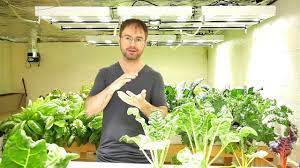An indoor basement garden is a great way to grow plants all year round, regardless of the weather outside. With a little bit of planning and preparation, you can create a thriving garden in your basement that will provide you with fresh herbs, vegetables, and flowers, while also improving the air quality in your home.
Here are some tips for creating an indoor basement garden:
Choose the Right Space
When selecting a space for your indoor basement garden, consider the following factors:
Lighting: Most plants need a minimum of six hours of sunlight per day, so make sure the space you choose gets enough natural light or has access to artificial lighting. If the basement does not get enough natural light, you may need to invest in grow lights to ensure your plants thrive.
Temperature: Plants grow best in a temperature range between 65 and 75 degrees Fahrenheit. Choose a space that is insulated and maintains a consistent temperature.
Humidity: Most plants prefer a higher level of humidity. Consider using a humidifier or placing a tray of water near your plants to increase humidity levels.
Ventilation: Good air circulation is important for plant growth. Make sure the basement has proper ventilation to prevent stagnant air.
Choose the Right Plants
When choosing plants for your indoor basement garden, consider the following factors:
Lighting requirements: Choose plants that are suited to the amount of natural or artificial light available in your basement.
Size: Choose plants that will fit comfortably in the space you have available.
Soil requirements: Some plants prefer specific types of soil or soil pH levels. Make sure you choose plants that are suited to the soil in your basement.
Water requirements: Some plants require more water than others. Choose plants that are suited to the amount of water you can provide.
Some good options for an indoor basement garden include herbs such as basil, thyme, and parsley, as well as leafy greens like lettuce and spinach. You can also grow small fruits like strawberries and cherry tomatoes, or flowering plants like African violets and orchids.
Provide Proper Lighting
In order for your indoor basement garden to thrive, you will need to provide adequate lighting. If your basement does not get enough natural light, you will need to invest in grow lights. There are many types of grow lights available, including fluorescent, LED, and high-intensity discharge lights. LED lights are energy-efficient and emit less heat than other types of grow lights, making them a good choice for an indoor basement garden.
When installing grow lights, make sure they are positioned at the correct distance from your plants. The distance will vary depending on the type of grow light you are using and the needs of your specific plants.
Choose the Right Containers
When choosing containers for your indoor basement garden, consider the following factors:
Drainage: Make sure the containers have proper drainage holes to prevent water from accumulating at the bottom.
Size: Choose containers that are appropriate for the size of your plants.
Material: Choose containers made of materials that are appropriate for your plants. For example, herbs and leafy greens can be grown in plastic or ceramic containers, while fruiting plants may do better in larger containers made of materials like terracotta.
Accessibility: Choose containers that are easy to move and maintain.
Provide Proper Air Circulation
Good air circulation is important for plant growth. Make sure your indoor basement garden has proper ventilation to prevent stagnant air. You can use a small fan to circulate air, or open windows or doors to allow fresh air to circulate.
Maintain Proper Humidity
Most plants prefer a higher level of humidity. Consider using a humidifier or placing a tray of water near your plants to increase humidity levels. You can also mist your plants with water to increase humidity levels.
Provide Proper Watering and Nutrients
Proper watering and nutrients are essential for a thriving indoor basement garden. When watering your plants, make sure to water thoroughly but do not let the soil become waterlogged. The frequency of watering will depend on the specific needs of your plants and the moisture level of the soil. You can check the moisture level by sticking your finger into the soil up to your second knuckle. If the soil feels dry at this depth, it is time to water.
In addition to water, plants also require nutrients for growth. You can add nutrients to the soil by using a balanced fertilizer. There are many types of fertilizers available, including organic and synthetic options. Choose a fertilizer that is appropriate for the specific needs of your plants.
Monitor for Pests and Diseases
Indoor basement gardens are not immune to pests and diseases. It is important to monitor your plants regularly for signs of pests or diseases, such as yellowing leaves, brown spots, or wilting. If you notice any signs of pests or diseases, take action immediately to prevent the problem from spreading. You can use natural remedies such as neem oil or insecticidal soap to control pests, or remove infected plants to prevent the spread of disease.
In conclusion, an indoor basement garden is a great way to grow plants year-round and provide fresh produce for your family. By following these tips, you can create a thriving garden in your basement and enjoy the benefits of fresh, healthy produce all year round. Remember to choose the right space, plants, lighting, containers, air circulation, humidity, watering and nutrients, and monitor for pests and diseases. Happy gardening!

